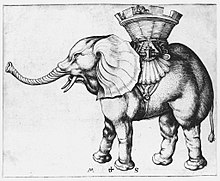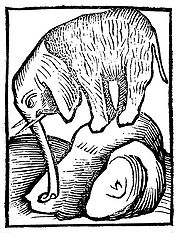Schongauer's elephant

Schongauer's elephant (around 1483 ) was of African origin and a diplomatic gift from John II of Portugal to Emperor Friedrich III. He was represented in two copper engravings by Martin Schongauer and his brother Ludwig . Various and spectacular deaths were said of him in chronicles.
Elephant trip
Presumably shipped from Portugal to Holland, the elephant first reached Cologne and then Frankfurt am Main . It was run by Hans Filßhover and was accompanied by a letter from Margrave Albrecht von Baden , who identified Filßhover as the emperor's servant and dear fellow and asked for honor for him and the hellfandt , the pious guest . In Frankfurt it was exhibited in Gallusgasse and painted life-size on the wall of a nearby house. For the same year, the elephant's stay in the city is noted in Christoph Schorer's Memminger Chronicle of 1660. His whereabouts are uncertain.
Since Abul Abbas , elephant of Charlemagne, the pachyderm was the first elephant in German-speaking territory after about 700 years; the Cremona elephant Frederick II had not exceeded its borders in the 13th century, just as the elephant Louis IX. , a first pachyderm of African origin. African elephants remained extremely rare in Europe. After the elephant of Louis XIV in the 17th century, the fourth known specimen of African provenance only reached Paris in 1861, Jumbo .
Schongauer copper engravings
The copper engraving signed “L + S” is attributed to Ludwig Schongauer (* around 1440; † 1494). The animal appears small and less realistic than the woodcut in Johann Prüss' Hortus sanitatis from 1497. What it has in common with the woodcut are the large ears and the comparatively steeply erect tusks, which can be found in pictures of elephants around 1500 as a result of this depiction. The print of the copper engraving in the Albertina in Vienna shows that it was made from a plate that had already been printed and therefore allows the assumption of a high edition as a souvenir sheet. Martin Schongauer's version may have served a similar purpose. He presented the animal as a tower-armored war elephant , in a presentation that was only intended for the docile Indian elephants .
Sources
The elephant in Frankfurt am Main in 1483 is documented in the cover letter by Albrecht von Baden and in the Frankfurt Chronicles . His African origins are illustrated in Schongauer's copperplate engravings. Nonetheless, Koelhoff's Chronicle of 1499 reports that in 1482 (!) The aventurre (= the animal handler) then took the elephant with him at sea and drowned with him in the English Channel. In the copy books of the city of Cologne there is a note for November 22nd, 1483 that the “servant of the emperor, Hans Viltzhover, brought an elephant to Cologne” which was led by a slave. This slave stabbed the elephant and escaped.
Later chronicles mention a whole series of elephants for the 15th century which, due to a lack of precise description, cannot be differentiated and, as phantoms, are based on transcription errors and incorrect dating. According to the Lersner Chronicle of 1706 , a specimen occasionally referred to as the “first German elephant” was sighted in Frankfurt for the year 1443; another source claims to have seen the animal there only in 1773. Lersner's chronicle has no entry about an elephant in Frankfurt for the year 1483. In the Chroniques d'Anjou et du Maine of 1529, Jehan de Bourdigné says that Alfonso V , King of Portugal, had for René of Anjou among other exotic animals around 1477 also brought an elephant from India. The sea route to India was not opened up by Vasco da Gama until 1497 ; the Portuguese, however, already had the coast of West Africa under their influence.
literature
- Stephan Oettermann : The elephant curiosity. An Elephantographia Curiosa . Syndicate, Frankfurt am Main 1982, ISBN 3-8108-0203-4
Individual evidence
- ↑ Oettermann (1980) pp. 102-104; there p. 102 the wording of the cover letter
- ↑ E. Flechsig: Martin Schongauer . Strasbourg 1946, p. 77; according to Oettermann (1982), p. 104
- ^ Regesta Imperii Before 1483 July 31 n.865: Regg.F.III. H. 4 n.865
- ↑ Koelhoffsche Chronik, 729 ; Digital copy from the Herzog August Library , Wolfenbüttel
- ↑ Oettermann (1982), p. 102; https://books.google.com/books?hl=de&id=QZEKAAAAIAAJ&pg=PA920 .
- ↑ Oettermann (1982), p. 101

